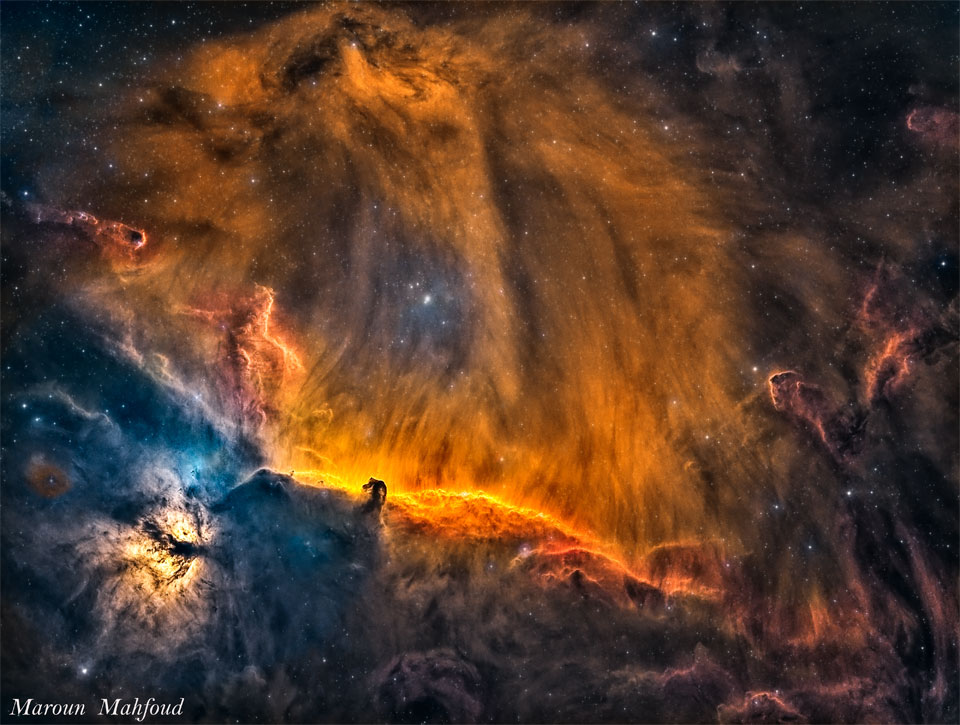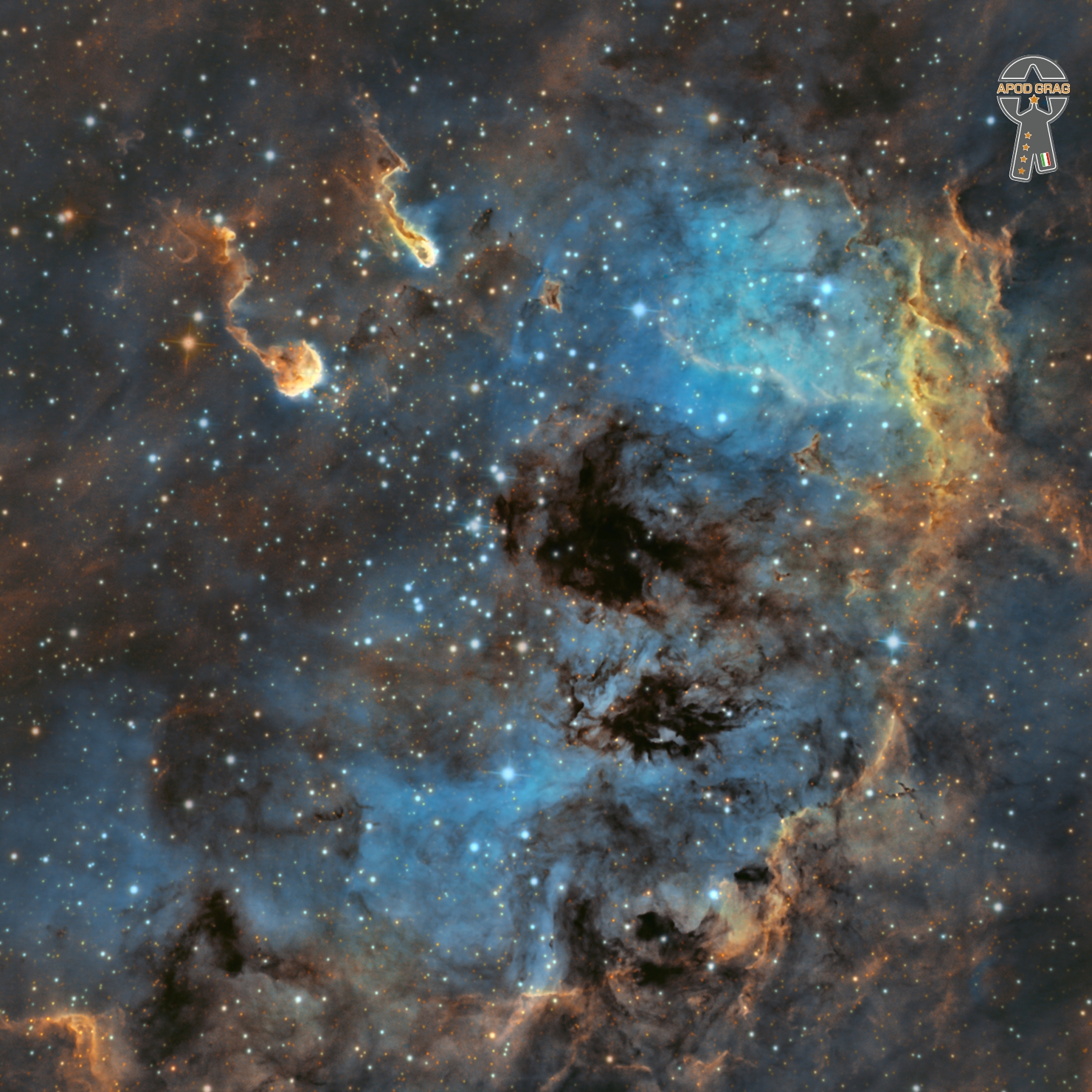Blog
A deep exposure shows the famous dark indentation that looks like a horse’s head, visible just left and below center, and known unsurprisingly as the Horsehead Nebula. The Horsehead Nebula (Barnard 33) is part of a vast complex of dark absorbing dust and bright glowing gas. To bring out details of the Horsehead’s pasture, an astrophotographer artistically combined light accumulated for over 20 hours in hydrogen (orange), oxygen (blue), and sulfur (green). The resulting spectacular picture captured from Raachine, Lebanon, details an intricate tapestry of gaseous wisps and dust-laden filaments that were created and sculpted over eons by stellar winds and ancient supernovas. The featured composition brings up another pareidolic animal icon — that of a lion’s head — in the expansive orange colored gas above the horse’s head. The Flame Nebulais visible just to the left of the Horsehead. The Horsehead Nebula lies 1,500 light years distant towards the constellation of Orion.

March 9th 1979 Jeanette Harris was born and raised in California’s post-Gold Rush town of Fresno in the center of the San Joaquin Valley. Reared by her mother, Annette, and her church organist father, Floyd Harris – both of deep spiritual faith and intense believers in the art of music – Jeanette and her older brother, Michael, received their love of God and family genetically.
“When I was 5, my father put a guitar in my hands,” Jeanette begins. “A year later, he switched me to piano with a private teacher. I didn’t like it. Reading treble and bass clefs was so overwhelming that I would cry, but it gave me a great jumpstart. One day while driving me to 4th grade, Mom was playing a cassette by Grover Washington, Jr. I remember looking at the picture of his alto sax. It was beautiful and Grover made it look so hip. I felt it would be the perfect instrument for me.”
Jeanette played saxophone and piano from grade school to high school where band teacher Steve Alcala also had her play in the Fresno City College jazz band even before she graduated high school. She won numerous awards and accolades, which led to a scholarship to attend Berklee in Boston where she earned a Bachelor of Arts degree in Music Performance.
Back in Fresno, Jeanette recorded her first self-released CD, Here and There, grabbing brother Michael to play drums with Patrick Olvera on bass, and began building a following by regularly packing Mike’s Pub & Pizzeria. She recorded her official debut album Reflections followed by Smooth Holiday Greetings on her family’s J&M Records (Jeanette & Michael’s initials, Mom and Dad’s funds).
Citing her influences, Jeanette continues, “(Saxophonist) Richard Elliot brought some serious R&B groove at a time when smooth jazz really needed more of that funk vibe, especially his song ‘Corner Pocket.’ I just loved his production! As a composer, Stevie Wonder’s music touches the hearts of people with lyrics that have strong meanings, and beautiful chords and melodies. And (guitarist) Norman Brown is the one that inspired me to want to be a performer when my parents took me to see him for my very first concert at The Bastille in Hanford, CA. He gave me chills!” After crossing paths with Brown on the road, Jeanette co-wrote a song with him that became the title track of her fourth CD, Saxified. Brown recorded the song on his Grammy nominated CD, 24/7, with a different title, “The Best is Yet to Come” featuring Gerald Albright. “To have Gerald playing a melody that I wrote is so amazing,” Jeanette shares.
Jeanette has played major events from The Coombs River Bend Ranch Festival to festivals in Japan and London. She has performed as a side musician with Howard Hewett and Deniece Williams and has opened shows for greats ranging from smooth jazz stars Kirk Whalum, Najee and The Rippingtons to R&B stars Babyface, Phil Perry and KEM. “I got a standing ovation opening for KEM,” Jeanette beams. “He came out to meet me and get my CD. His people said he never does that! That let me know my music does crossover.”
more...Ustad Zakir Hussain (born 9 March 1951) is an Indian tabla virtuoso, composer, percussionist, music producer and film actor. He is the eldest son of tabla player Ustad Allah Rakha.
He was awarded the Padma Shri in 1988, and the Padma Bhushan in 2002, by the Government of India presented by President Abdul Kalam. He was also awarded the Sangeet Natak Akademi Award in 1990, given by the Sangeet Natak Academy, India’s National Academy of Music, Dance and Drama. In 1999, he was awarded the United States National Endowment for the Arts‘ National Heritage Fellowship, the highest award given to traditional artists and musicians. Zakir Hussain was born on 9 March 1951 in Mahim (a suburb of Mumbai) in a Punjabi Dogra family. Hussain was born to tabla maestro Ustad Alla Rakha. His mother’s name was Bavi Begum. Although their family name is Qureshi, Zakir was given the surname Hussain. He attended St. Michael’s High School in Mahim, and briefly attended St. Xavier’s College, Mumbai. Hussain was a child prodigy. His father taught him Pakhawaj from the age of 3 years. His father would wake him up at 3 a.m. and would teach him vocally by reciting different rhythms till 6 a.m. Zakir’s father Alla Rakha belonged to the Punjab gharana tradition of tabla-playing.
more...Randolph Denard Ornette Coleman (March 9, 1930 – June 11, 2015) was an American jazz saxophonist, violinist, trumpeter, and composer known as a principal founder of the free jazz genre, a term derived from his 1960 album Free Jazz: A Collective Improvisation. His pioneering performances often abandoned the chordal and harmony-based structure found in bebop, instead emphasizing a jarring and avant-garde approach to improvisation.
Born in Fort Worth, Texas, Coleman began his musical career playing in local R&B and bebop groups, and eventually formed his own group in Los Angeles featuring members such as Ed Blackwell, Don Cherry, Charlie Haden, and Billy Higgins. In 1959, he released the controversial album The Shape of Jazz to Come and began a long residency at the Five Spot jazz club in New York City. His 1960 album Free Jazz would profoundly influence the direction of jazz in that decade. Beginning in the mid-1970s, Coleman formed the group Prime Time and explored funk and his concept of Harmolodic music.
Coleman’s “Broadway Blues” and “Lonely Woman” became genre standards and are cited as important early works in free jazz. His album Sound Grammar received the 2007 Pulitzer Prize for Music. AllMusic called him “one of the most important (and controversial) innovators of the jazz avant-garde“.
more...Samuel Osmond Barber II (March 9, 1910 – January 23, 1981 Westchester, PA) was an American composer, pianist, conductor, baritone, and music educator, and one of the most celebrated composers of the 20th century. The music critic Donal Henahan stated, “Probably no other American composer has ever enjoyed such early, such persistent and such long-lasting acclaim.”[1] Principally influenced by nine years of composition studies with Rosario Scalero at the Curtis Institute and more than twenty-five years of study with his uncle, the composer Sidney Homer, Barber’s music usually eschewed the experimental trends of musical modernism in favor of utilizing traditional 19th-century harmonic language and formal structure that embraced lyricism and emotional expression. However, elements of modernism were adopted by Barber after 1940 in a limited number of his compositions, such as an increased use of dissonance and chromaticism in the Cello Concerto (1945) and Medea’s Dance of Vengeance (1955), and the use of tonal ambiguity and a narrow use of serialism in his Piano Sonata (1949), Prayers of Kierkegaard (1954), and Nocturne (1959).
Barber was adept at writing both instrumental and vocal music. His works became successful on the international stage and many of his compositions enjoyed rapid adoption into the classical performance canon. In particular, his Adagio for Strings (1936) has earned a permanent place in the concert repertory of orchestras, as has that work’s adaptation for chorus, Agnus Dei (1967). He was awarded the Pulitzer Prize for Music twice: for his opera Vanessa (1956–57) and for the Concerto for Piano and Orchestra (1962). Also widely performed is his Knoxville: Summer of 1915 (1947), a setting for soprano and orchestra of a prose text by James Agee. At the time of Barber’s death, nearly all of his compositions had been recorded.[1] Many of his compositions were commissioned or first performed by such noted organizations and artists as the Boston Symphony Orchestra, the Philadelphia Orchestra, the New York Philharmonic, the Metropolitan Opera, Vladimir Horowitz, Eleanor Steber, Raya Garbousova, John Browning, Leontyne Price, Pierre Bernac, Francis Poulenc, and Dietrich Fischer-Dieskau.[1]
While Barber composed a significant body of purely instrumental music, two-thirds of his compositional output was dedicated to writing art songs for voice and piano, choral music, and songs for voice and orchestra. Some of his most frequently performed songs include both the solo voice and choral versions of Sure on this shining night (solo version from 1938 and choral version from 1961) with text by Agee and the song cycle Hermit Songs (1953) with anonymous texts by Irish monks from eighth through the thirteenth centuries. This emphasis on sung material was rooted in his own brief career as a professional baritone in his 20s which inspired a life long love of composing vocal music. Barber recorded his own setting of Arnold‘s “Dover Beach” accompanying his own singing voice on the piano in 1935 for NBC, and was also featured weekly on NBC Radio in 1935–1936 in performance of German lieder and art songs. He also occasionally served as conductor for performances and recordings of his works with symphony orchestras during the 1950s and had a brief career teaching composition at the Curtis Institute from 1939–1942.
Barber was in a relationship with the composer Gian Carlo Menotti for more than 40 years. The two men lived at Capricorn, a house just north of New York City, where they frequently hosted parties with academic and music luminaries. Menotti served as Barber’s librettist for two of his three operas. After the relationship ended in 1970, the two men remained close friends until Barber’s death from cancer in 1981.
more...FREE UKRAINE
more...Juan de Dios Ventura Soriano (8 March 1940 – 28 July 2021), better known as Johnny Ventura nicknamed El Caballo Mayor, was a Dominican singer and band leader of merengue and salsa. The merengue legend was a legislator of the Lower House between 1982 and 1986. He also served as vicemayor of Santo Domingo from 1994 to 1998, and as mayor of Santo Domingo from 1998 to 2002.
He began his career as a singer when he presented himself with some friends in a program of devotees which was broadcast by La Voz de la Alegríaweekly. The young Ventura, only 16 years of age, obtained first place of the participants. A little later, he started appearing in the programs of devotees which were sponsored by La Voz Dominicana. When Ventura Soriano appeared for the first time in the TV show: La TV busca una estrella, that was broadcast Friday night at seven, they rang the bell. In the following week, like a champion, Juan de Dios returned to be welcomed in the same competition. He practiced, worked and was crowned for the hit. Then he won first prize. Thereupon he won a lot of prizes in the devotees programs, until he was finally rewarded with the much desired scholarship which the broadcasting company, property of José Arismendy Trujillo Molina, gave for young talents. With La Voz Dominicana Juan de Dios studied music, vocal techniques and expression. This made Ventura one of the most famous singers in Latin America.
more...William Edward Childs (born March 8, 1957) is an American jazz pianist, composer, arranger and conductor from Los Angeles, California, United States.
When he was sixteen he attended the Community School of the Performing Arts sponsored by the University of Southern California. He studied music theory with Marienne Uszler and piano with John Weisenfluh. From 1975–’79 he attended the University of Southern California and received a degree in composition under the tutelage of Robert Linn.
While still a teen, Childs was playing professionally and he made his recording debut in 1977 with the J. J. Johnson Quintet during a tour of Japan, documented as “the Yokohama Concert”. He gained significant attention during the six years (1978–84) he spent in trumpeter Freddie Hubbard‘s group. His early influences as a pianist included Herbie Hancock, Keith Emerson, and Chick Corea and as a composer, Paul Hindemith, Maurice Ravel and Igor Stravinsky. Childs nevertheless had an original conception of his own from near the start, developing his own voice as both a pianist and a composer in jazz and classical music genres.
more...
Gábor István Szabó (March 8, 1936 – February 26, 1982) was a Hungarian American guitarist whose style incorporated jazz, pop, rock, and Hungarian music.
Szabó was born in Budapest, Hungary. He began playing guitar at the age of 14. In the aftermath of the Hungarian revolution of 1956, he moved to California and later attended the Berklee College of Music in Boston between 1958 and 1960. While visiting family in Budapest during the Christmas holiday, Szabó was admitted to the hospital and finally succumbed to the liver and kidney ailments he suffered from and died on February 26, 1982. He was buried in Farkasréti Cemetery.
more...
George Edward Coleman (born March 8, 1935) is an American jazz saxophonist known for his work with Miles Davis and Herbie Hancock in the 1960s. In 2015, he was named an NEA Jazz Master.
Coleman was born in Memphis, Tennessee. He was taught how to play the alto saxophone in his teens by his older brother Lucian Adams, inspired (like many jazz musicians of his generation) by Charlie Parker. Among his schoolmates were Harold Mabern, Booker Little, Frank Strozier, Hank Crawford, and Charles Lloyd.
more...John Smith Hurt (March 8, 1893 – November 2, 1966 Teoc, MS), better known as Mississippi John Hurt, was an American country blues singer and guitarist.
Raised in Avalon, Mississippi, Hurt taught himself to play the guitar around the age of nine. He worked as a sharecropper and began playing at dances and parties, singing to a melodious fingerpicked accompaniment. His first recordings, made for Okeh Records in 1928, were commercial failures, and he continued to work as a farmer.
Dick Spottswood and Tom Hoskins, a blues enthusiast, located Hurt in 1963 and persuaded him to move to Washington, D.C. He was recorded by the Library of Congress in 1964. This helped further the American folk music revival, which led to the rediscovery of many other bluesmen of Hurt’s era. Hurt performed on the university and coffeehouse concert circuit with other Delta blues musicians who were brought out of retirement. He also recorded several albums for Vanguard Records.
Hurt returned to Mississippi, where he died, in Grenada, in 1966, aged about 73 years old.
Material recorded by him has been re-released by many record labels. His songs have been recorded by Bob Dylan, Dave Van Ronk, Jerry Garcia, Beck, Doc Watson, John McCutcheon, Taj Mahal, Bruce Cockburn, David Johansen, Bill Morrissey, Gillian Welch, Josh Ritter, Chris Smither, Guthrie Thomas, Parsonsfield, and Rory Block.
more...An energetic outburst from an infant star streaks across this image from the NASA/ESA Hubble Space Telescope. This stellar tantrum — produced by an extremely young star in the earliest phase of formation — consists of an incandescent jet of gas travelling at supersonic speeds. As the jet collides with material surrounding the still-forming star, the shock heats this material and causes it to glow. The result is the colourfully wispy structures, which astronomers refer to as Herbig–Haro objects, billowing across the lower left of this image. Herbig–Haro objects are seen to evolve and change significantly over just a few years. This particular object, called HH34, was previously captured by Hubble between 1994 and 2007, and again in glorious detail in 2015. HH34 resides approximately 1250 light-years from Earth in the Orion Nebula, a large region of star formation visible to the unaided eye. The Orion Nebula is one of the closest sites of widespread star formation to Earth, and as such has been pored over by astronomers in search of insights into how stars and planetary systems are born. The data in this image are from a set of Hubble observations of four nearby bright jets with the Wide Field Camera 3 taken to help pave the way for future science with the NASA/ESA/CSA James Webb Space Telescope. Webb — which will observe at predominantly infrared wavelengths — will be able to peer into the dusty envelopes surrounding still-forming protostars, revolutionising the study of jets from these young stars. Hubble’s high-resolution images of HH34 and other jets will help astronomers interpret future observations with Webb.

John Townes Van Zandt (March 7, 1944 – January 1, 1997 Fort Worth, TX) was an American singer-songwriter. He wrote numerous songs, such as “Pancho and Lefty“, “For the Sake of the Song“, “If I Needed You“, “Tecumseh Valley”, “Rex’s Blues”, and “To Live Is to Fly“, that are widely considered masterpieces of American songwriting. His musical style has often been described as melancholy and features rich, poetic lyrics. During his early years, Van Zandt was respected for his guitar playing and fingerpicking ability.
In 1983, six years after Emmylou Harris had first popularized it, Willie Nelson and Merle Haggard covered Van Zandt’s song “Pancho and Lefty”, reaching number one on the Billboard country music chart. Much of Van Zandt’s life was spent touring various dive bars, often living in cheap motel rooms and backwood cabins. For much of the 1970s, he lived in a simple shack without electricity or a telephone.
Van Zandt’s influence has been cited by countless artists across multiple genres and his music has been recorded or performed by Bob Dylan, Willie Nelson, Lyle Lovett, Merle Haggard, Norah Jones, Emmylou Harris, Counting Crows, Steve Earle, Rodney Crowell, Robert Earl Keen Jr., Nanci Griffith, Guy Clark, Wade Bowen, Gillian Welch, Richard Buckner, Pat Green, Colter Wall, Jason Isbell, Calvin Russell, Natalie Maines, Jason Molina, Kevin Morby, Stephen Duffy, Doc Watson and Frank Turner.
He suffered from a series of drug addictions and alcoholism, and was given a psychiatric diagnosis of bipolar disorder. When he was young, the now-discredited insulin shock therapy erased much of his long-term memory.
Van Zandt died on New Year’s Day 1997 from cardiac arrythmia caused by health problems stemming from years of substance abuse. A revival of interest in Van Zandt blossomed in the 2000s. During the decade, two books, a documentary film (Be Here to Love Me), and numerous magazine articles were written about him. Townes Van Zandt died in the early morning hours of January 1, 1997, at the age of 52. His official cause of death was “natural” cardiac arrhythmia.
more...
Louis Albert Cottrell Jr. (March 7, 1911 – March 21, 1978) was a Louisiana Creole jazz clarinetist and tenor saxophonist. He was the son of the influential drummer Louis Cottrell, Sr., and grandfather of New Orleans jazz drummer Louis Cottrell. As leader of the Heritage Hall Jazz Band, he performed at the famous Carnegie Hall in 1974.
Louis Cottrell was born into an upper-class Creole musical family in New Orleans. His father, Louis “Old Man” Cottrell, Sr., was a famed drummer, and cornetist Manny Perez was his godfather. The young Cottrell grew up around such great musicians as Barney Bigard, John Robichaux, and A.J. Piron. Cottrell studied clarinet under Lorenzo Tio Jr. and Bigard. He began his career in the 1920s with the Golden Rule Orchestra, and then in 1925 played with Paul “Polo” Barnes. Later in the 1920s he worked with Chris Kelly and Kid Rena, then in 1929 found work on the riverboat SS Island Queen with Lawrence Marrero‘s Young Tuxedo Brass Band and Sidney Desvigne. These were the years when he became a prominent union organizer. He joined Don Albert‘s orchestra soon after, recording an album with the orchestra in 1935 under the Vocalion label. He tried his hand at composing, and with Lloyd Glenn and Albert wrote, “You Don’t Love Me (True).”[5] Rhythm and blues bandleader Paul Gayten would later approach Cottrell to record “You Don’t Love Me” and it became one of the first hits of the R & B New Orleans era, having made it to the number 5 spot nationally on the R & B top ten charts. Cottrell toured widely throughout North America with Albert until 1939.
more...More Posts
- World Music with Melchor de Marchena
- Daily Roots with Yami Bolo
- The Cosmos with NGC 4945
- Malachi Favors Day
- John Lee Hooker Day
- Claude Debussy Day
- World Music with DHOAD GYPSIES OF RAJASTHAN
- Daily Roots with Burning Spear
- The Cosmos with M42
- Leon Parker Day
- Art Farmer Day
- Count Basie Day
- World Music with Gamelon Cudamani
- Daily Roots with Dennis Brown
- The Cosmos with NGC 6589
- Isaac Hayes Day
- Frank Rosolino Day
- Jimmy Raney Day
- World Music with Ortega, Silveira and Elizarde
- Daily Roots with Nicodemus

